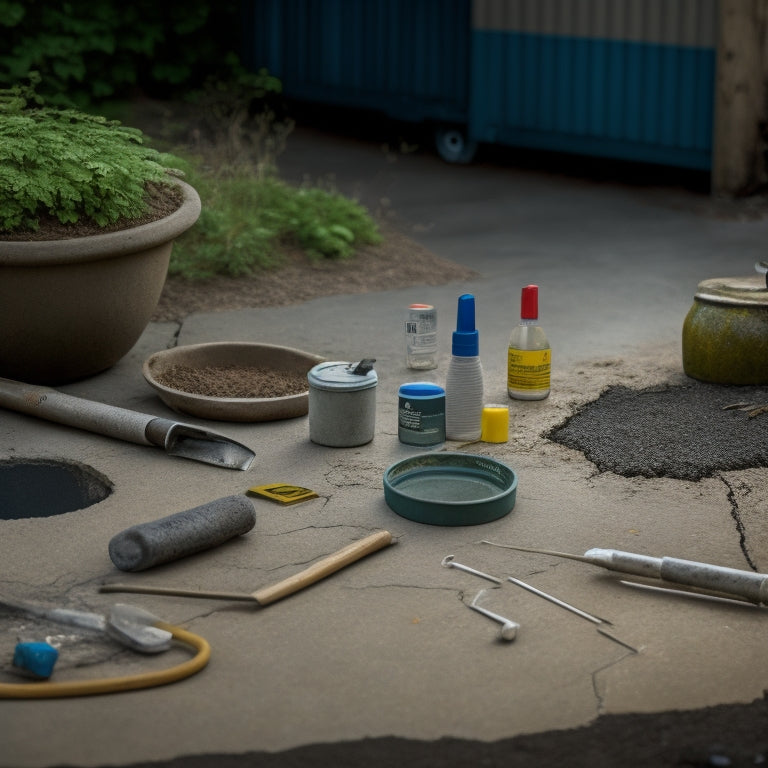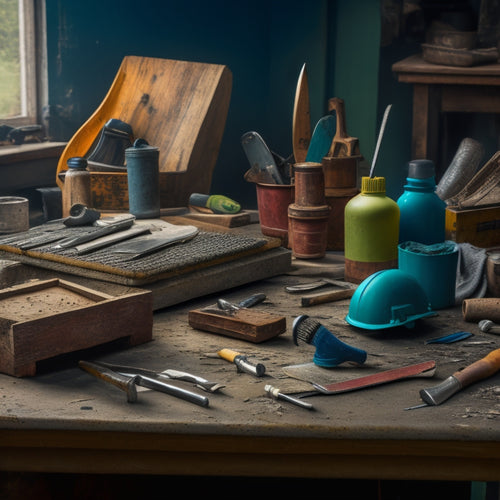
Why You Need These Concrete Crack Repair Tools
Share
You need a thorough set of concrete crack repair tools to guarantee a successful and long-lasting repair, because relying on makeshift or inferior tools can lead to subpar results, wasted time, and even compromised safety. From robust chiseling tools to specialized epoxy injection and filling tools, each component plays a critical role in the repair process. With the right tools, you can guarantee a clean and stable surface, precise control over epoxy flow, and a professional finish that assures aesthetic and structural integrity. Now, discover how each tool contributes to a successful concrete crack repair.
Key Takeaways
• Robust chiseling and scraping tools remove deteriorated concrete, ensuring a clean surface for repair.
• Effective crack cleaning and preparation tools identify and prepare cracks for filling, ensuring a strong bond between old and new concrete.
• Epoxy injection and filling tools enable precise control over epoxy flow, ensuring complete crack filling and repair effectiveness.
• Sealant application and smoothing tools guarantee durable, long-lasting repairs with even coverage and a professional finish.
• Safety and protective gear essentials protect workers from physical harm and hazardous substances, ensuring a safe and successful repair process.
Essential Chiseling and Scraping Tools
You'll need a set of robust chiseling and scraping tools to effectively remove deteriorated concrete and prepare the surface for repair. These tools are vital in removing loose and damaged concrete, allowing you to create a clean and stable surface for repair.
When it comes to chiseling techniques, you'll want to use a combination of hand chisels and pneumatic chisels to break up and remove damaged concrete. For scraping methods, use a scraper or a wire brush to remove any remaining debris and dust. A robust scraper will help you remove old and damaged concrete, while a wire brush will guarantee a clean surface free of dust and debris.
Crack Cleaning and Preparation Tools
What tools do you need to clean and prepare the crack for repair, ensuring a strong bond between the old and new concrete?
To achieve a successful repair, you'll need to remove dirt, debris, and oil residue that can compromise the bonding process. A wire brush or scrub brush is essential for scrubbing the crack and removing loose material. For more stubborn debris, a pressure washer can be used to blast away dirt and grime.
When it comes to crack identification techniques, a magnifying glass or crack detection dye can help you identify the full extent of the crack.
Once the crack is clean, you'll need to prepare the surface materials by roughening the concrete to create a strong bond. A surface retarder can be applied to prevent the new concrete from bonding to the old, ensuring a clean, strong repair.
With the right tools, you'll be able to properly clean and prepare the crack, laying the foundation for a successful repair.
Epoxy Injection and Filling Tools
With the crack thoroughly cleaned and prepared, the next step involves injecting epoxy into the crack using specialized tools designed to guarantee a precise and controlled flow of resin. This is where epoxy injection and filling tools come into play.
These tools are essential in ensuring that the epoxy is properly dispensed and fills the crack completely. You'll need tools that can accurately control the injection pressure and flow rate to achieve ideal results.
Some essential tools to have in your arsenal include:
-
Epoxy dispensing guns: These guns allow you to precisely control the flow of epoxy, ensuring a consistent and even application.
-
Injection ports: These ports provide a secure connection between the dispensing gun and the crack, preventing epoxy from leaking out during the injection process.
-
Pressure pots and regulators: These tools enable you to adjust the injection pressure, which is vital in achieving the right flow rate for the specific epoxy formulation techniques you're using.
Sealant Application and Smoothing Tools
After confirming the epoxy has fully cured, you're ready to apply a sealant to the repaired crack, and specialized tools are required to accomplish this task effectively.
You'll need a selection of sealant application tools, including brushes, rollers, and squeegees, to guarantee a smooth, even coat. The type of sealant you're using will dictate the best application technique. For example, acrylic-based sealants work well with brushes, while polyurethane-based sealants are better suited to rollers.
It's essential to choose the right tool for the job to prevent uneven application and guarantee a strong bond between the sealant and the concrete.
Smoothing tools, such as trowels and scrapers, are also vital for removing excess sealant and achieving a professional finish.
By using the correct sealant application and smoothing tools, you'll be able to achieve a durable, long-lasting seal that protects the repaired crack from further damage.
With the right tools and techniques, you'll be able to complete the job efficiently and effectively.
Surface Preparation and Finishing Tools
You'll typically need to employ a range of surface preparation and finishing tools to ascertain the repaired area blends seamlessly with the surrounding concrete. This is where attention to detail is vital, as a poorly finished repair can be aesthetically unpleasing and compromise the structural integrity of the concrete.
To achieve a professional-looking finish, you'll need the right tools for the job. Here are some essential surface preparation and finishing tools to have in your arsenal:
-
Power trowels and floats: For applying and smoothing out finishing textures, such as broom finishes or power trowel finishes.
-
Surface leveling tools: To ascertain the repaired area is level with the surrounding concrete, using techniques like screeding or darbying.
-
Edging tools: For creating clean, defined edges around the repaired area, which is critical for a seamless blend with the surrounding concrete.
Safety and Protective Gear Essentials
Protective gear is essential when working with concrete crack repair tools, as the process can expose you to hazardous materials and physical risks. You'll be handling chemicals, dealing with heavy equipment, and working in potentially hazardous environments, so it's vital to prioritize your safety.
Here are some essential protective gear items to include in your arsenal:
| Protective Gear | Purpose |
|---|---|
| Protective Gloves | Prevent skin contact with harsh chemicals and abrasions |
| Safety Goggles | Shield your eyes from flying debris and chemical splashes |
| Respirator Mask | Filter out airborne particles and hazardous fumes |
| Steel-Toed Boots | Protect your feet from heavy objects and tools |
| Knee Pads | Reduce fatigue and prevent knee injuries from prolonged kneeling |
Frequently Asked Questions
Can I Use Concrete Crack Repair Tools for Other Masonry Repairs?
When tackling masonry repairs, you might wonder if concrete crack repair tools can be used for other tasks. The answer is yes, but with caution.
While these tools are designed for concrete, you can adapt them for alternative repair materials.
However, it's crucial to understand the unique requirements of each material and adjust your masonry repair techniques accordingly.
How Do I Store and Maintain My Concrete Crack Repair Tools?
When you're not using your concrete crack repair tools, store them in a dry, protected area to prevent rust and damage.
Clean your tools regularly, paying attention to crevices and small parts.
For maintenance tips, lubricate moving parts, inspect for wear, and sharpen cutting edges.
Proper tool cleaning and maintenance will extend their lifespan, ensuring they remain effective for your next repair job.
Are Concrete Crack Repair Tools Suitable for DIY or Only Professionals?
When deciding between DIY or professional use, consider your concrete crack repair project's scope and complexity.
If you're tackling a small, straightforward job, DIY-friendly tools like epoxy injection kits and patching compounds might suffice.
However, for larger, more intricate projects, you'll want to opt for heavy-duty, specialized tools like hydraulic injection pumps and precision drill bits, typically reserved for professionals.
Can I Rent Concrete Crack Repair Tools Instead of Buying Them?
When deciding whether to rent or buy concrete crack repair tools, you'll want to weigh the cost benefits.
If you're a DIYer or occasional user, renting might be the way to go. Rental options can save you upfront costs and storage space.
However, if you plan on using these tools frequently, buying might be more cost-effective in the long run.
Consider your usage frequency and calculate the costs before making a decision.
Are There Any Specific Certifications for Concrete Crack Repair Tools?
When selecting concrete crack repair tools, you'll want to guarantee they meet certification requirements.
Look for tools that comply with industry standards, such as those set by the International Concrete Repair Institute (ICRI).
Additionally, prioritize tool safety by choosing equipment with built-in safety features, like protective guards and ergonomic design.
Conclusion
You've got the know-how to tackle that concrete crack repair job, but without the right tools, you'll be stuck in the mud.
Don't let your project crumble - invest in these must-haves. You might think, 'I can make do with what I've got,' but trust us, these specialized tools will save you time, effort, and costly rework.
Visualize the perfect repair: a seamless blend of old and new concrete, thanks to the precision and control these tools provide.
Related Posts
-

Must-Have Handheld Tools for Concrete Repair
When tackling a concrete repair project, it is crucial to have the right handheld tools to achieve a professional fin...
-

7 Must-Have Tools for Concrete Repair Organization
To effectively organize your concrete repair projects, you'll need a thorough toolkit that includes a well-planned st...
-

10 Best Tools for Sealed Concrete Finishing Success
When it comes to sealed concrete finishing success, you need a robust arsenal of specialized tools. Start with essent...


